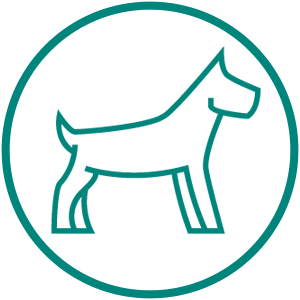
Female Canine Urinary Incontinence

Disease Overview
Urinary incontinence can affect up to one out of five spayed female dogs and develops an average of 2.9 years after the dog has been spayed.9
Urethral sphincter mechanism incompetence (USMI) is the most common non-neurogenic cause of urinary incontinence in adult female dogs. USMI is a condition associated with decreased urethral resistance, bladder neck position, and urethral length. Predisposing factors include spaying, medium or large body size, breed, docked tail, and obesity. It is estimated that 4.9% to 20% of spayed female dogs are affected by USMI.9
As seen in humans, a decrease in circulating estrogen levels is associated with a loss in the tone in the lower urogenital tract, particularly in the sphincter muscle that surrounds the urethra. Decreased circulating estrogen levels appear to reduce bladder storage capacity and reduce the sensitivity of target tissues to sympathetic stimulation. These effects may contribute to involuntary leakage of urine.8
Clinical signs of female canine urinary incontinence
- Urinary dribbling
- Involuntary loss of urine
- Signs of discomfort or behavioral changes
- Scalding of the skin or severe eczema
- An offensive odor (in severe cases)
- Excessive licking of genital area
At-risk breeds
About 30% of female dogs that develop urinary incontinence weigh more than 45 lbs.10
Certain breeds are at higher risk for developing urinary incontinence, including:11
- Boxer
- Doberman Pinscher
- English Springer Spaniel
- German Shepherd
- Giant Schnauzer
- Irish Setter
- Old English Sheepdog
- Rottweiler
- Weimaraner
References:
8. Robinson D, Cardozo LD. The role of estrogens in female lower urinary tract dysfunction. Urology. 2003;62(4 Suppl 1):45–51.
9. Ettinger SJ, Feldman EC, eds. Textbook of Veterinary Internal Medicine: Diseases of the Dog and Cat. 7th ed. St. Louis, MO: Saunders Elsevier; 2010:162, 1905.
10. Holt PE. Urological Disorders of the Dog & Cat—Investigation Diagnosis and Treatment. London: Manson Publishing; 2008:150.
11. Holt PE. Urinary incontinence in the bitch due to sphincter mechanism incompetence: prevalence in referred dogs and retrospective analysis of sixty cases. J Small Anim Pract. 1985;26(4):181–190.
